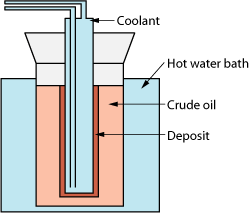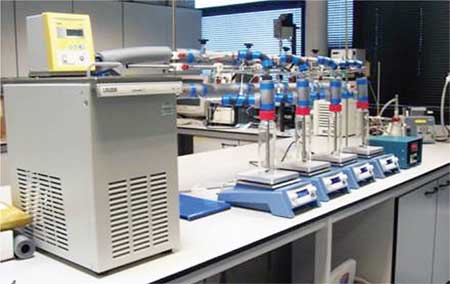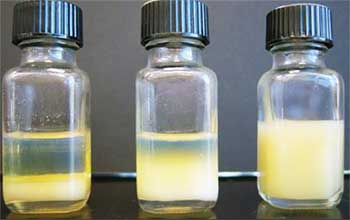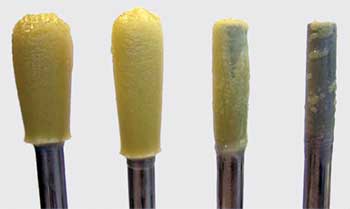Successful inhibition in the field depends on good laboratory techniques that mimic the process system and field deposition models.
Jonathan J. Wylde, Clariant Oil Services
Deposition of paraffins in upstream production operations can restrict flow, causing production loss, and can lead to corrosion under the deposits. Specifically tailored paraffin solvent treatments have been successfully applied to aid the removal of deposits, and specialty inhibitors have been used to prevent further deposition. This article reviews the current best practices for the identification, evaluation and control of paraffin deposition in oil production systems.
Case histories illustrate how the implementation of chemical treatment packages has vastly improved the production of heavy paraffinic crudes through removal, inhibition, dispersion and pour point depression.
PARAFFIN DEPOSITION IN UPSTREAM OPERATIONS
Crude oils naturally contain paraffinic, waxy components, defined as aliphatic hydrocarbon molecules with the empirical formula CnH2n+2 (n is most commonly greater than 18).
Paraffins can exist in three forms:
- Macrocrystalline: These tend to be dominated by straight-chained n-alkanes and are classically defined by paraffin deposits found in subsea and export pipelines.
- Semi-microcrystalline: This is an intermediate form of macro- and microcrystalline paraffins.
- Microcrystalline: These tend to be cycloalkanes and branched alkanes often associated with asphaltenes and other solid deposits. They tend to be encountered in tank bottoms as a sludge-like deposit.
When paraffin precipitates, the crude oil viscosity increases, creating higher drag and pressures. Deposition on the walls of tubulars, flowlines and pipelines can increase surface roughness, thus increasing the differential pressure. Physical restriction of the pipeline can also occur, restricting flow or increasing energy costs to maintain flow.
The solubility of paraffin in crude oil is primarily dependent on temperature. Minor factors that lower paraffin solubility in crude include pressure, asphaltene content, light-end alkane removal and the presence of foreign matter.
Paraffin deposition occurs by means of molecular diffusion, typically movement of paraffin molecules to a colder region, such as a pipeline wall. Shear dispersion and gravity settling can also have a minor influence.1
CONTROL OF PARAFFIN
There are two broad categories of paraffin control: mechanical and chemical. Mechanical methods are usually installed in the design phase of a project and include insulation of equipment and pipelines, dilution of the paraffin content via mixing of crude streams, hot oiling and pipeline pigging.
Chemical control methods include the use of paraffin solvents, paraffin crystal modifiers, dispersants and pour point depressants.
The best paraffin solvents tend to be aliphatic hydrocarbons. The lower the melting point of a paraffin, the greater the solubility in a given solvent. The longer the chain length of a solvent, the higher its paraffin solvency due to lower polarity. Macrocrystalline paraffin has a low solubility in polar solvents, whereas microcrystalline paraffin is soluble to an appreciable extent in polar solvents.2
Paraffin dispersants function through interaction with the paraffin crystal surface, causing repulsion of the paraffin particles; they are essentially water-wetting agents.3 Typical chemistries include olefin sulphonates, polyalkoxylates and amine ethoxylates. Injection rates can vary from 50 to 500 ppm (volume), and products are very system specific.
Paraffin inhibitors are classed as either paraffin crystal modifiers or Pour Point Depressants (PPDs). Crystal modifiers rely on co-precipitation with paraffins, and therefore must be injected above the cloud point of a crude oil. This helps to explain why they are system specific. A high-efficacy crystal modifier should contain structural sequences capable of co-crystallization with paraffin.4 Typical chemistries include ethylene-vinyl acetate copolymers, acrylate polymers/copolymers, and maleic anhydrite copolymers and esters. It has been hypothesized that PPDs operate in the same manner as crystal modifiers—via nucleation and co-precipitation—so it is not surprising that they are chemically similar. PPDs have commonly been observed functioning as crystal modifiers, but the opposite is not as common.
LAB EVALUATION TECHNIQUES
Laboratory evaluations tend to be detailed due to the difficulty of measuring efficacy in the field. The highest confidence for field application results from combinations of different types of tests.
Paraffin content. There are several methods to determine the total paraffin content of a crude oil. Any technique used should be based on ASTM UOP 46-85. Gas chromatography can be used to determine the carbon chain distribution as well as the paraffin content and types of paraffin. The percentage of paraffin in a crude oil gives the first indication of the severity of this flow assurance challenge in the field. Typically, a paraffin content of less than 1% is not cause for concern, but anything greater than 1% merits further investigation.
 |
|
Fig. 1. Diagram of a cold finger cell.
|
|
Cloud point. Also known as wax appearance temperature, this indicator is defined as the highest temperature at which paraffins become isolated from the bulk crude. Optical techniques are used to determine this point in a condensate (ASTM D2500-05), but this cannot be used for opaque crude oils. Methods for determining the cloud point of opaque crude samples include rotational viscometry, thermal staged microscopy, differential scanning calorimetry, Fourier transform infrared and filter plugging techniques.
Pour point. This is the lowest temperature at which fluid movement of the crude occurs as defined in ASTM D97-96a. Repeatability can be poor when performed manually, and automatic pour point testers can improve this. This test can be used to screen a wide range of paraffin inhibitors quickly and efficiently before more detailed testing.
 |
|
Fig. 2. A typical cold finger apparatus showing multiple cells.
|
|
Cold finger testing. This method most usefully estimates the applied dose rate in the field. The test is based on the fact that the paraffin in a crude oil/condensate will deposit on a surface whose temperature is below the cloud point. A cold finger chilled by a circulating bath is placed in a crude sample, which itself is placed in a water bath. The temperature of the finger is set to the coolest temperature in the system, and the water bath is set to the temperature of the bulk crude at the same point in the system.
Figures 1 and 2 show a schematic description and photograph of a typical test apparatus. Efficient paraffin inhibitors and dispersants will prevent paraffin crystals from depositing on the surface of the cold finger. Comparative determination of the mass of paraffin gained from treated and untreated crude allows assessment of percentage inhibition efficacy.
Tube blocking. This technique measures the differential pressure across a narrow-bore capillary as chilled crude oil is flowed through. Tube blocking can approximate applied field dose rates very well, but can be over-sensitive due to the size of the capillary used. Some light-end losses can occur because a large crude reservoir needs to be maintained above the cloud point.
Cold filter plugging point. Most commonly used for distillate and fuel samples, this technique involves cooling a sample to a pre-selected temperature and then applying a vacuum of 20 mbar to the sample. The product is drawn through a filter into a calibrated aspiration pipette. If the sample takes more than 60 s to reach the upper barrier detector during the aspiration phase or if it fails to return completely into the test vessel, the cold filter plugging point is reached.
Yield stress. This method is designed to mimic pipeline restart scenarios. Homogenized crude oil is pumped through a capillary immersed in a temperature-controlled bath. Flow is stopped for several hours, and the increase in pressure required to pump the crude oil is monitored and compared to pre-shut-in pressures. Yield stress is measured from the point at which steady flow begins; from this value, the restart pressure of a pipeline can be calculated.
Rolled ball solvency. This is acknowledged as a standard method for evaluating the efficiency of paraffin solvents. In this test, equally sized balls of paraffin are put in contact with the test solvent. Visual observations are made of the dissolution and dispersion of the paraffin. Post-test filtration and weighing can be used to quantify efficacy. This is often a qualitative technique, but is useful for gauging different solvents against one another.
FIELD EVALUATION
The proactive monitoring of paraffin deposits and buildup in the field is very challenging. Often the first indication of paraffin buildup is after the failure of equipment or blockage of pipes. However, some indirect evidence may be obtained through close monitoring of pressure readings and differential pressures. Also, coupons can be used to optimize injection rates, and use of portable viscometers can monitor the effect of PPDs or paraffin crystal modifiers.
FIELD DEPLOYMENT OF PARAFFIN INHIBITORS
Field deployment techniques are illustrated by two case histories.
Subsea paraffin formation, Gulf of Mexico. Three satellite wells, each on individual structures, produced through dry tree wells and subsea flowlines to the host processing facility. One well in particular had a severe paraffin deposition potential. Production from the well was 6 MMcfd, 30 bopd and 6 bwpd. Gross production flowed via a 4-in. subsea flowline to the host facility 2 mi away. The produced condensate had 44.5°API gravity and a high paraffin content of 14.5 wt%. Cloud point was 125°F, and pour point was 96°F.
The flowline temperature upstream of the choke was 130°F at 4,350 psia, and downstream it was 70°F at 1,250 psia. After flowing to the host facility, the fluids had cooled to 63.2°F at 1,200 psia. A paraffin solvent was being deployed at two location on this production stream. Firstly, 100 quarts per day (20,000 ppm or 2% based on condensate) was being injected into the flowline downstream of the production choke on the satellite platform. Injection of an additional 80 quarts per day (16,000 ppm or 1.6% based on condensate) also occurred into the same production stream at the flowline riser arriving at the processing host facility. This gave a total treat rate of 36,000 ppm (3.6%), yet this treatment was having very limited success because samples taken from the production separator contained copious paraffinic solids.
A large work scope was undertaken, including pour point experimentation and cold finger work. Once a solution had been evaluated, test work was performed to determine the foaming or emulsion tendencies potentially created by all mitigation methods recommended.
Pour point testing showed that the incumbent chemical injection rate had very little effect on the pour point, proving field observations. An esterified copolymer-based paraffin inhibitor/PPD at 5,000 ppm was able to reduce the pour point to 5°F and maintained paraffin as a transportable slurry, Fig. 3.
 |
|
Fig. 3. Pour point (and dispersion) properties. From left to right: 5,000-ppm esterified copolymer, 5,000-ppm maleic anhydride and 36,000-ppm incumbent solvent.
|
|
Cold finger experiments (Fig. 4) found excellent inhibition (91%) using 5,000-ppm esterified copolymer. This is a very high dose rate, but was a reflection of the high paraffin content. The incumbent solvent, on the other hand, performed poorly, showing 13% inhibition when dosed at 36,000 ppm.
 |
|
Fig. 4. Cold finger sleeves after removal from the test. From left to right: blank, 36,000-ppm incumbent, 2,500-ppm esterified copolymer and 5,000-ppm esterified copolymer.
|
|
Field application of 5,000-ppm esterified copolymer occurred upstream of the choke on the satellite platform. A clear step change in performance was seen. Field measurement of pour point and paraffin content showed that deposition was very unlikely to be occurring in the flowline, as paraffin content was the same upstream of injection and at the host facility. Pour point was also suppressed, and visual paraffin was not apparent in samples.
Fieldwide paraffin control evaluation, offshore Trinidad. This field comprised a host facility with two tiebacks. All wells were dry trees, but in-field flowlines had been identified as having a risk of paraffin formation. The incumbent chemical program injected 10 ppm of a maleic anhydrite copolymer formulation to all the tieback departing fluids. This was determined from laboratory test work performed on pre-production crude oil samples taken during the drilling campaign, which were contaminated with drilling mud and completion brine.
The evaluation aimed to determine the efficacy of the current treatment program, and whether paraffin inhibitor mitigation was required. Samples were taken from the online wells during an extensive campaign, the first in the field’s history. Test work was first conducted to evaluate the waxing tendency of individual samples. This was combined with process information gathered at a recent detailed offshore platform survey. Evaluation of the current mitigation method sought to determine what effect 10-ppm incumbent had on the basic properties of the crude oil samples. Cold finger tests were performed on commingled samples—blended to mimic the process streams in the subsea flowlines.
The paraffin content of the crude oils ranged from 1.38wt% to 2.90wt%. Cloud point varied from 136°F to 144°F, and pour point was never greater than 9°F. The only areas identified as having a paraffin deposition risk were the fluids arriving from the tiebacks, where arrival temperatures were lower than the cloud points. At 10, 50 and 100 ppm of the paraffin inhibitor, there was little or no effect observed on the cloud points and pour points of the tieback crude oil mixtures.
Cold finger testing found that greater than 60% inhibition efficacy was realized when 10-ppm incumbent was used for one of the tiebacks and 50 ppm was used for the other tieback. Based on the results, it was recommended to maintain these injection rates, and no field issues have been experienced to date.
CONCLUSIONS
Paraffin deposition is a common observation in the production of hydrocarbons. This can be a particular challenge in subsea operations where the cool ambient conditions induce the deposition potential.
Laboratory testing is essential to build an understanding of the mechanisms, severity and reasons for paraffin deposition. Any one technique for evaluation should not be relied on for making field recommendations; rather a combination of multiple techniques should be used.
An understanding of temperature changes throughout the process is critical to identify the high-risk areas and best location for injection. The most successful field applications are those that have been founded on good laboratory techniques that have been custom designed to mimic the process system and field deposition models. 
|
THE AUTHOR
|
 |
Jonathan Wylde earned a BSc degree with honors in geology and a PhD degree at the University of Bristol in the UK. Dr. Wylde joined Clariant Oil Services in 2002, initially working in the scale team of the R&D Center in Aberdeen, UK. Over the next four years he managed the production chemistry on several major North Sea assets. He recently became the Business Manager for Clariant Oil Services Canada based in Calgary, Alta.
|
|
| |
|








